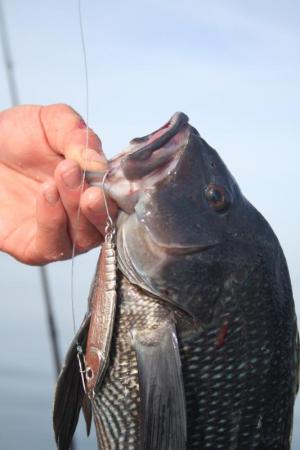It looks like recreational fishermen in Delaware are going to be the victims of bad data compounded by even worse data used by fish counters who know both sets of data are bad, but used them anyway. Why, you may ask, would reasonably intelligent people with at least a bachelor’s degree in science do such a thing? The answer, as always, is because this is the best available data. Even when they know the data is horribly wrong and using it will cost real people their jobs, they still use this junk with the excuse, “It’s the best available data.” I suppose that’s how they manage to sleep at night.
What this boils down to is a reduced season for black sea bass and an increased size limit from 12.5 to 13 inches. The reduction was made necessary because the fish counters went back to the time before the new Marine Recreational Information Program and applied those lousy numbers to those that were taken, I believe, in 2018 and 2019, to determine that recreational fishermen overfished their total allowable catch in those years, and we have to make up for those overages.
Now, the reason we have a new system for MRIP is because the old system was ruled to be unreliable. The new system, while a little better than the old one, is still bad. So, what the fish counters did was crunch two bad numbers together to produce a very suspect number that showed them we overfished several years ago.
Now consider this. The same agency that produced these idiotic numbers also found that black sea bass are not overfished and overfishing is not occurring. In addition, they determined that the spawning stock biomass is two-and-a-half times the level needed to sustain the stock.
With that kind of stock, we should be getting a larger bag limit, not having a two-week-shorter season and a half-inch-longer minimum size limit.
Then there are summer flounder. That stock also is not overfished and overfishing is not occurring. There is some concern about poor recruitment, but not that much. As a result, the fish counters have decided to drop a half-inch off the minimum size, and we will be able to take home a 16-inch flounder.
Math was always my worst subject in school, so I don’t exactly understand what multiplying factor the fish counters use once they have the data from shoreside interviews, and phone and mail surveys. Whatever it is, it’s wrong. Anyone who has spent even a little time fishing from shore in Delaware knows there has never been a two-month time frame when shoreside anglers caught more than 1,000 black sea bass. That’s just the tip of the iceberg when it comes to bad data that anyone who has spent even a little time fishing would recognize right away. That leads me to conclude that the fish counters don’t fish. At least the Scientific and Statistical Committee is finally rejecting this bad data, and that gives me some hope for the future. As for now, we are going to have to live with bad data and bad results.
Fishing report
I wish I had better news for you here, but so far spring has not been kind to the saltwater angler. Last week, we had seven straight days of small-craft advisories, and so far this week, the air temperatures have climbed close to 80 degrees. Water temperatures in the bay and ocean are hovering between the upper 40s and lower 50s. That is much too cold for flounder to start feeding. We need water in the mid-50s to get the bite started.
White perch fishing has been good in all the tidal creeks and rivers from Leipsic to Indian River. Bloodworms have been the best bait, and some of the perch have topped one pound. Small rockfish have been caught along with the perch, so be sure you use circle hooks when using bait. Also be aware that striped bass season is closed in the Delaware River from a line at the C&D Canal north to the Pennsylvania state line, and in the entire Nanticoke River.
There has been some activity at Indian River Inlet. Small tog have been caught on green crab or sand fleas. The occasional keeper is taken along with the shorts. Small rockfish have been caught during the predawn hours on soft plastics.
With small craft advisories up, only a few boats left the dock last week. Those that did caught tog at the Outer Wall and the Ice Breakers on sand fleas and green crab.
The surf gave up a few large smooth dog sharks, which is better than nothing.
























































